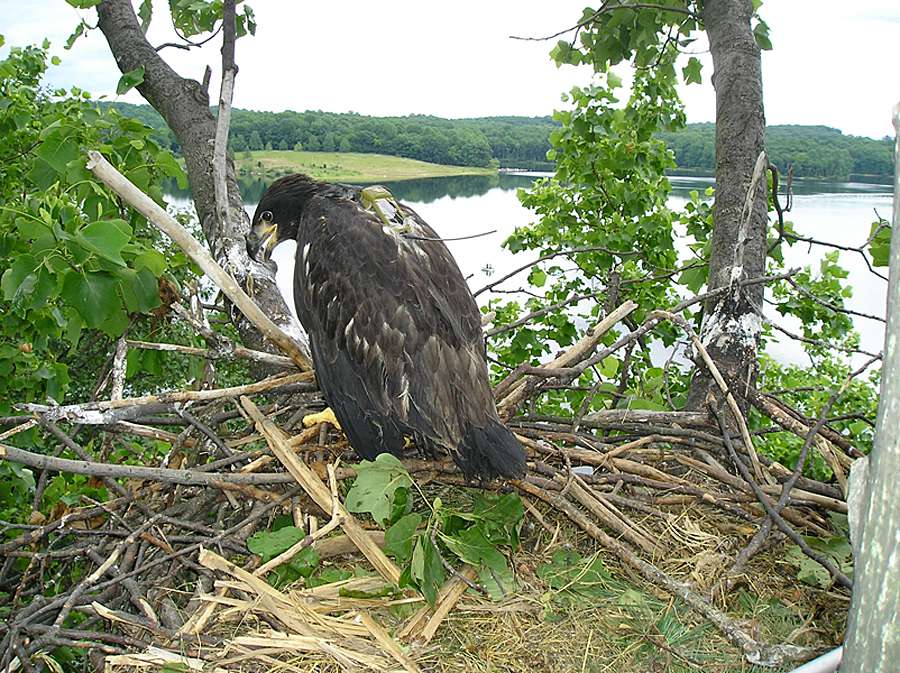Historic population counts of Bald Eagles are not available for New Jersey, but documentation does exist that indicated the population was exactly one nesting pair by 1970! According to the New Jersey Division of Fish and Wildlife (NJDFW). “massive bald eagle decline was the result of persecution, followed by the impact of widespread use of the persistent pesticide DDT from the mid 1940’s until it was banned in 1972.”
Bald Eagles are usually spotted gliding over Merrill Creek reservoir (MCR) during the fall Hawk Watch conducted on Scott’s Mountain. In the winter of 1999, continued observation of a pair of Bald Eagles that had not migrated through, but in fact stayed at MCR, revealed that Merrill Creek Reservoir would become (at that time) only the second nesting location for Bald Eagles in the Northern half of the state!
In 2011, The Merrill Creek Owners Group (MCOG) donated the funds needed to purchase state of the art tracking equipment for the eagle monitoring project. Originally the funds were to be used to establish an eagle cam that would provide a “bird’s eye” view of the activity in an eagle nest located at the reservoir. Unfortunately, the remote location of the nest at MCR presented insurmountable problems that prevented a cam from being installed. So instead, the nest camera funds were utilized to purchase (2) satellite transmitters.
On June 13, 2011, NJDFW biologists and staff from MCR, banded 8-week-old Bald Eagle chicks (a male and a female) that were in a nest on the eastern edge of the Reservoir. This was the 8th time that biologists had banded young eagles from Merrill Creek nests, but it was the first time that they affixed a satellite transmitter to each of the birds. In fact, this was the first time that the NJDFW biologist had ever used a satellite transmitter on Bald Eagles. NJDFW had previously used traditional transmitters on eagle fledglings that were hacked (introduced) in the lower Delaware River area from 1983-1989, but this was the first opportunity to conduct a long-term research project with Bald Eagles in NJ. The solar-powered transmitters, monitored via satellites, allowed the birds to be monitored for up to three years as they move away from the nest and begin to establish their own territories.
Results from those studies indicated MCR Eagles venturing as far north as Massachusetts, as far east as the tip of Long Island, as far south as the Chesapeake Bay near Baltimore, and as far west as Cumberland, County PA!
These days at MCR we have two active Bald Eagle nests, one at the eastern shoreline and one at the western shoreline that continue to produce eaglets each year!
Check out one of the MCR Eagles landing a huge fish from the reservoir-MCR EAGLE SWIMMING WITH HUGE FISH
Access Eagle Movement Data
Eagles can travel great distances in a single day and their seasonal migration can range up to 2,500 miles. For this reason, the use of transmitters is essential to track the movement of these birds. Several GPS locations are collected for each bird on a daily basis. This data that is being collected will be useful in a variety of projects such as:
- Migration patterns
- Night roosting habits
- Impacts of land type and weather to migration and roosting
Satellite Monitoring Project
Conserve Wildlife Eagle Tracking – (Click to see maps of eagles that were fitted with transmitters in NJ)
Conserve Wildlife Eagle Tracking
Click to see maps of eagles that were fitted with transmitters in NJ
Merrill Creek Reservoir
34 Merrill Creek Road
Washington, NJ 07882
(908) 454-1213 (ph)
(908) 454-2747 (f)
*Play MCR's Tree Finder Game !
Along the trails at MCR there are 9 different individual trees that have FACES. More Info...




